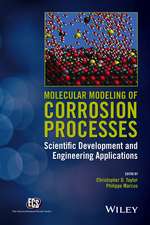Modern Aspects of Electrochemistry: No. 15
Editat de John O M. Bockrisen Limba Engleză Paperback – 25 apr 2012
| Toate formatele și edițiile | Preț | Express |
|---|---|---|
| Paperback (2) | 389.11 lei 6-8 săpt. | |
| Springer Us – 25 apr 2012 | 389.11 lei 6-8 săpt. | |
| Springer Us – 30 apr 2012 | 391.99 lei 6-8 săpt. |
Preț: 389.11 lei
Nou
Puncte Express: 584
Preț estimativ în valută:
74.46€ • 80.86$ • 62.55£
74.46€ • 80.86$ • 62.55£
Carte tipărită la comandă
Livrare economică 22 aprilie-06 mai
Preluare comenzi: 021 569.72.76
Specificații
ISBN-13: 9781461574637
ISBN-10: 1461574633
Pagini: 380
Ilustrații: XIV, 362 p.
Dimensiuni: 140 x 216 x 20 mm
Greutate: 0.44 kg
Ediția:Softcover reprint of the original 1st ed. 1983
Editura: Springer Us
Colecția Springer
Locul publicării:New York, NY, United States
ISBN-10: 1461574633
Pagini: 380
Ilustrații: XIV, 362 p.
Dimensiuni: 140 x 216 x 20 mm
Greutate: 0.44 kg
Ediția:Softcover reprint of the original 1st ed. 1983
Editura: Springer Us
Colecția Springer
Locul publicării:New York, NY, United States
Public țintă
ResearchCuprins
1 The Electrochemical Splitting of Water.- I. Introduction.- II. Units.- III. Electrochemistry.- IV. Improvements Achieved in Water Electrolysis.- V. Novel Ways to Reduce Activation Overvoltage.- VI. Magneto-Electrolysis.- VII. Steam Electrolysis.- VIII. Series or Parallel Electrolyzers.- IX. Economical Electrolyzers.- X. Advanced Electrolyzers.- XI. Super Electrolyzers.- XII. State-of-the-Art Electrolyzers.- XIII. Applications of Electrolytic Hydrogen Generator Technology.- XIV. Cost of Hydrogen Production.- XV. Hydroelectric Resources.- XVI. Hydrogen Storage.- References.- 2 Interfacial Charge Transfer Reactions in Colloidal Dispersions and Their Application to Water Cleavage by Visible Light.- I. Introduction.- II. Dynamics of Photoinduced Electron-Transfer Reactions in Simple Micellar Assemblies.- III. Interfacial Electron- and Hole-Transfer Reactions in Colloidal Semiconductor Dispersions.- IV. The Principles of Redox Catalysis.- V. Light-Induced Water Cleavage in Microheterogeneous Solution.- VI. Splitting of Hydrogen Sulfide and Reduction of Carbon-Dioxide as Alternative Light-Energy-Storing Reactions.- VII. Conclusions.- References.- 3 Lithium Batteries with Liquid Depolarizers.- I. Introduction.- II. Discharge Reaction Mechanism.- III. Battery Design Procedures.- IV. Materials of Construction.- V. Processing and Assembling.- VI. Testing and Evaluation.- VII. Applications.- VIII. Deactivation, Disposal, and Reclamation.- References.- 4 Physical Mechanisms of Intercalation.- I. Introduction.- II. Review of Intercalation Systems.- III. Thermodynamics of Intercalation and Lattice Gas Models.- IV. Interactions between Intercalated Atoms.- V. Kinetics of Intercalation Cells.- VI. One-Dimensional Lattice Gas.- VII. Conclusions.- References.- 5 Some Fundamental Aspectsof Electrode Processes.- I. Introduction.- II. The Meaning of Absolute Scale Potential in Electrode Kinetics.- III. The Effect of Applied Potential on the Fermi Level in Metal and Semiconductors.- IV. Fermi Energies in Solution.- V. Distribution of Electron States in Ions in Solution.- VI. The Calculation of Electronic Energy States of Ions in Solution.- VII. Applications of the Born—Landau Equation.- VIII. Nonadiabaticity.- IX. The Mechanism of Proton Transfer at Interfaces.- X. The Semiconductor/Solution Interface.- XI. Auger Neutralization.- Notation.- References.





